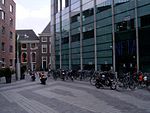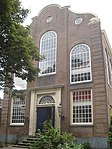Netherlands Film Academy
Amsterdam University of the ArtsCinema of the NetherlandsFilm organization stubsFilm schools in the Netherlands

The Netherlands Film Academy (Dutch: Nederlandse Filmacademie) (NFA) was founded in 1958. The academy is the only recognised institute in the Netherlands that offers training to prepare for the work in the various crew disciplines. Specialisation is possible in fiction directing, documentary directing, screenwriting, editing, producing, sounddesign, cinematography, production design, and interactive multimedia/visual effects. The Netherlands Film Academy is situated at Markenplein 1. It is a division of the Amsterdam University of the Arts.
Excerpt from the Wikipedia article Netherlands Film Academy (License: CC BY-SA 3.0, Authors, Images).Netherlands Film Academy
Meester Visserplein, Amsterdam Centrum
Geographical coordinates (GPS) Address Website External links Nearby Places Show on map
Geographical coordinates (GPS)
| Latitude | Longitude |
|---|---|
| N 52.368333333333 ° | E 4.9047222222222 ° |
Address
Nederlandse Film en Televisie Academie (Filmacademie)
Meester Visserplein
1011 MV Amsterdam, Centrum
North Holland, Netherlands
Open on Google Maps











